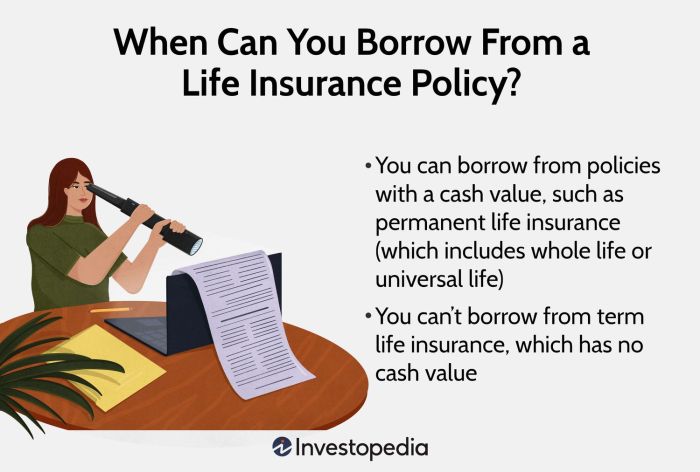Life insurance, often viewed as a safety net for loved ones, can also serve as an unexpected financial resource. Many policies offer the possibility of borrowing against the accumulated cash value, providing a potential lifeline during financial emergencies. However, this seemingly simple solution involves complexities, potential pitfalls, and a careful consideration of long-term financial implications. Understanding the nuances of borrowing against your life insurance policy is crucial to making informed decisions that align with your financial goals.
This guide delves into the intricacies of accessing funds through your life insurance, examining various policy types, loan processes, associated costs, and the potential consequences. We’ll compare borrowing against life insurance to alternative financing options, helping you determine if it’s the right choice for your specific circumstances. By the end, you’ll have a clear understanding of whether borrowing from your life insurance is a viable and prudent financial strategy for you.
Financial Implications and Alternatives

Borrowing against your life insurance policy can offer a convenient source of funds, but it’s crucial to weigh the financial implications carefully and compare it to other financing options. Understanding the potential long-term effects and exploring alternatives will help you make an informed decision that aligns with your overall financial goals.
Comparison of Borrowing Options
Borrowing against life insurance offers a potentially lower interest rate than other loans, particularly if the loan is from the insurance company itself. However, interest still accrues, reducing your death benefit and potentially impacting your beneficiaries. Personal loans, while potentially having higher interest rates, are typically easier to obtain and don’t directly impact your life insurance policy. Home equity loans utilize your home’s equity as collateral, offering potentially lower interest rates than personal loans but carrying the risk of foreclosure if payments are missed. The best option depends on your credit score, the amount needed, and your risk tolerance. For instance, a person with excellent credit might secure a lower interest rate on a personal loan, while someone with less-than-perfect credit might find borrowing against a policy more feasible, despite the implications for the death benefit.
Strategies for Managing Debt from Life Insurance Loans
Careful budgeting and a structured repayment plan are vital when borrowing against life insurance. Prioritize paying down the loan as quickly as possible to minimize interest accumulation and protect the death benefit. Consider creating a detailed budget that allocates funds specifically for loan repayment. Exploring options like debt consolidation, if applicable, could simplify repayments and potentially lower interest rates. Regularly review your loan statement to monitor interest accrual and ensure you remain on track with payments. Failure to repay could lead to policy lapse, resulting in the loss of the death benefit. For example, someone borrowing $10,000 could allocate $200 per month to repay the loan within a reasonable timeframe.
Decision-Making Flowchart
A flowchart visualizing the decision-making process would begin with the need for financing. The first branching point would ask: “Is life insurance borrowing an option?” If no, the process would proceed to assess other options like personal loans or home equity loans. If yes, a second branching point would assess the interest rates of all available options, including borrowing from the life insurance policy, personal loans and home equity loans. The lowest interest rate option would be compared against the potential impact on the death benefit from the life insurance loan. The final decision node would select the most suitable option based on this comparison, considering financial circumstances and risk tolerance. The flowchart would visually represent this decision tree, guiding the user through a logical sequence of questions and choices.
Potential Long-Term Financial Implications
Borrowing against life insurance can have several long-term financial implications. The accumulation of interest reduces the death benefit payable to beneficiaries, potentially leaving them with less financial security. The loan itself might reduce the cash value of the policy, limiting future borrowing options. In the event of a policy lapse due to non-payment, the entire policy and death benefit would be lost. Furthermore, the interest paid on the loan represents a loss of potential investment returns that could have been generated had the funds been invested elsewhere. For example, a $50,000 loan with a 5% interest rate could result in a significant reduction in the death benefit over time, impacting the financial stability of the beneficiaries. It’s crucial to consider these long-term effects before deciding to borrow against your life insurance policy.
Last Word

Borrowing against your life insurance policy presents a unique financial opportunity, but it’s essential to approach it with caution and a thorough understanding of the implications. While it can offer immediate access to funds, overlooking the potential long-term effects on your policy’s cash value and death benefit could prove detrimental. Carefully weigh the pros and cons, compare available options, and consider seeking professional financial advice before making a decision. Remember, a well-informed choice today can safeguard your financial future and protect your loved ones.
FAQ Overview
What happens to my death benefit if I borrow against my life insurance?
The death benefit is typically reduced by the outstanding loan amount plus any accrued interest at the time of death. However, some policies may have different clauses, so reviewing your policy’s terms is vital.
Can I borrow 100% of my policy’s cash value?
No, most insurers impose limits on the loan amount, typically less than the full cash value to maintain a buffer. The exact percentage varies depending on the policy and the insurer.
What are the tax implications of borrowing against my life insurance?
Generally, loans against life insurance are not taxable events. However, interest may be taxable if it is not repaid before the policy matures or lapses. Consult a tax professional for specific guidance.
What if I can’t repay the loan?
Failure to repay the loan can lead to the policy lapsing, meaning the death benefit is forfeited. The insurer may also take other actions, depending on the policy terms. It’s crucial to maintain a repayment plan.